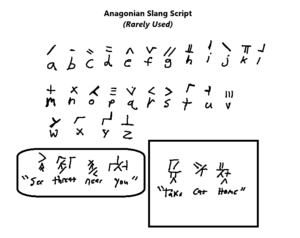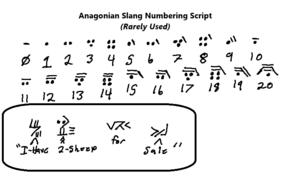History of the Anagonian Language
Introduction
The Anagonian Language is a rich tapestry of history and evolution, deeply influenced by its ancient roots in the Draconic Script and later transformed by the arrival of the Seurian invasion over two millennia ago. The earliest form of written communication in Anagonia can be traced back to the Drekamythian Dragons, whose primitive script formed the basis for the first version of the language.
Draconic Script required its users to combine symbols in a unique fashion, where letters were arranged both vertically and horizontally. Typically, a dragon would write a primary letter, followed by four additional letters directly below, creating a vertical stack. This method of combination could be repeated side by side to form longer words or phrases. The writing process was heavily tied to the practical needs of dragons and their environment. Draconic script was inscribed on stone and clay tablets using claw-like tools, later transitioning to primitive parchment or other materials that could hold ink made from natural substances like charcoal or plant-based dyes.
When it came to numbering, the system was rudimentary. To express quantities, dots or slashes were used alongside the symbols, often representing multiples of ten or, at most, hundreds. However, the system’s limitations became apparent, as more complex arithmetic concepts could not be easily conveyed in this ancient script. Still, this script served as the backbone of Anagonian communication, trade, and cultural exchange for centuries before the introduction of more advanced systems.
Approximately 2,422 years ago, the Seurian invasion forever changed the trajectory of the Anagonian language. As the Seurians brought with them their own written script and linguistic traditions, Anagonians, upon their victory in the war, began studying the strange symbols and words of the Seurians. Interestingly, they noticed a striking similarity between Seurian script and their own draconic claw marks. This realization sparked a slow but transformative process in which Seurian linguistic elements were gradually assimilated into the Anagonian script.
The influence of Seurian language on Anagonian culture was profound. Over time, as trade and cultural exchanges continued, Seurian syntax, numbering systems, and written forms began to merge with traditional Anagonian language. This process took centuries, leading to the creation of the Modern Anagonian Script, a hybrid of the ancient draconic symbols and the more structured Seurian script. This modern script, unlike its predecessor, was far better suited for the complexities of modern society, able to convey numbers, mathematical operations, and advanced written communication with clarity and precision.
History of Draconic Script
Draconic Language & Speech
History of the Modern Anagonian Script
Modern Anagonian Language & Speech
Evolution of Numbers & Mathematics
Anagonian Slang Script & Language
Though Modern Anagonian is widely used in urban centers and formal settings, a more informal, rural variant known as the Anagonian Slang Script persists in the remote regions of Anagonia. This script is primarily used by those living in the "boonies" or "backhills", far from the influence of urban education centers. Any Anagonian, regardless of race or background, who grows up in these rural areas and receives even the most basic education will be familiar with this script.
The Anagonian Slang Script is a fusion of Old Draconic Script and Modern Anagonian, but with a notable difference: it adheres to the traditional Draconic writing rules, such as structuring words in rows and columns, often written vertically or in block patterns, as opposed to the linear, left-to-right format of Modern Anagonian. This gives the script a rougher and more ancient appearance, reminiscent of the older days when the Draconic Script dominated written communication.
The language that accompanies this script is equally rough and reflects the informal, rural dialects of ancient Anagonia. In many ways, it can be considered Anagonia’s version of "southern slang," where pronunciation is less refined, words are abbreviated or slurred, and sentence structure is more flexible. This slang often invokes older phrases, expressions, and metaphors that have long since fallen out of use in urban centers but remain popular in rural regions.
Anagonian Slang Audio Clip Example
Mathematical Slang Script Variant
In addition to the language itself, there is also a rudimentary form of mathematical slang script used in rural areas. This variant still follows the basic principles of Draconic mathematics, incorporating simple symbols and markings to denote numbers. However, in keeping with the informal nature of the script, these markings are often abbreviated, with symbols for multiplication, division, and addition simplified to slashes, dots, or crosses.
This mathematical slang is only suitable for basic arithmetical operations, such as counting, trading, or simple transactions within local communities. More complex calculations are seldom needed, and when required, individuals from these rural regions often turn to the standardized Modern Anagonian system for precision.

